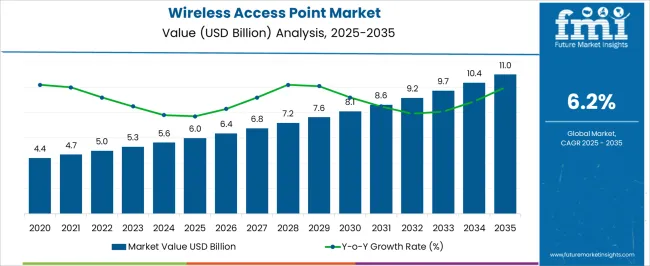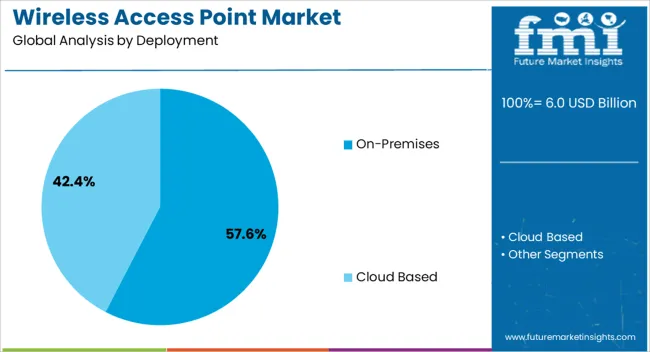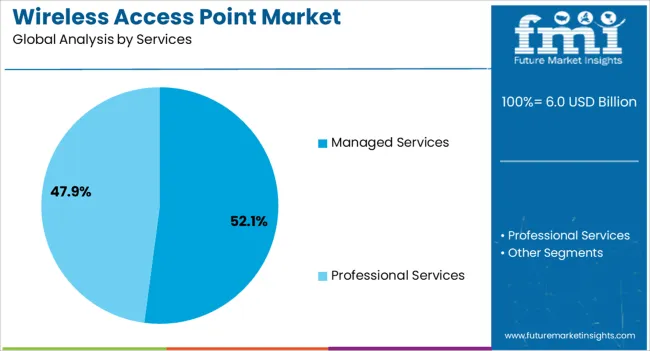The Wireless Access Point Market is estimated to be valued at USD 6.0 billion in 2025 and is projected to reach USD 11.0 billion by 2035, registering a compound annual growth rate (CAGR) of 6.2% over the forecast period.

| Metric | Value |
|---|---|
| Wireless Access Point Market Estimated Value in (2025 E) | USD 6.0 billion |
| Wireless Access Point Market Forecast Value in (2035 F) | USD 11.0 billion |
| Forecast CAGR (2025 to 2035) | 6.2% |
The wireless access point market is advancing steadily, propelled by the exponential growth in data traffic, rising adoption of cloud applications, and the proliferation of connected devices. Industry reports and telecom operator disclosures have emphasized the role of high-performance access points in ensuring seamless connectivity, particularly as enterprises transition toward hybrid work models and bandwidth-intensive applications.
Regulatory encouragement for digital infrastructure expansion, coupled with investments in 5G and Wi-Fi 6/6E, has accelerated market adoption. Enterprises and service providers are prioritizing secure, scalable, and low-latency connectivity to support smart offices, digital campuses, and large-scale IoT ecosystems.
Additionally, product innovation from technology vendors, including AI-enabled network management and automated troubleshooting, is reshaping service delivery models. Looking ahead, demand is expected to remain strong across enterprises, telecom operators, and public infrastructure deployments, with segmental growth led by on-premises solutions, managed services, and telecom end users. These segments reflect the balance between security, operational efficiency, and high-volume connectivity needs across industries.

The On-Premises segment is projected to account for 57.6% of the wireless access point market revenue in 2025, securing its leadership position due to enterprise demand for direct control over network performance and security. Organizations have favored on-premises deployments to ensure data sovereignty, compliance with regulatory standards, and customization of network management.
IT teams have also leveraged on-premises solutions to optimize network latency and maintain uninterrupted access in bandwidth-intensive environments such as corporate offices and educational campuses. Furthermore, on-premises access points offer better visibility into network operations and easier integration with existing IT infrastructure.
While cloud deployments are expanding, the persistence of data-sensitive industries such as banking, defense, and healthcare has reinforced the strength of this segment. Its ability to deliver consistent, secure, and tailored connectivity makes the On-Premises segment the preferred choice for enterprises seeking robust control and performance.

The Managed Services segment is anticipated to hold 52.1% of the wireless access point market revenue in 2025, reflecting growing enterprise reliance on third-party expertise for network management. Rising network complexity, particularly with Wi-Fi 6/6E rollouts and IoT integration, has driven organizations to adopt managed service models for proactive monitoring, configuration, and support.
Telecom operators and IT service providers have expanded their managed offerings, enabling enterprises to reduce capital expenditure and shift to predictable subscription-based models. Managed services also provide scalability and rapid adaptability, making them attractive to businesses undergoing digital transformation.
Industry announcements have highlighted increased bundling of managed services with hardware and software solutions, further enhancing value propositions. The emphasis on operational efficiency, cost reduction, and advanced threat protection has positioned managed services as the preferred approach to access point deployment, especially among mid- to large-sized enterprises.

The Telecom segment is projected to contribute 28.4% of the wireless access point market revenue in 2025, establishing itself as the leading end-user category. Growth in this segment has been driven by the rapid expansion of mobile data usage and the need for operators to enhance coverage and capacity across both urban and rural regions.
Wireless access points have been integrated into telecom infrastructure to support Wi-Fi offloading, small cell backhaul, and hotspot deployment, alleviating pressure on cellular networks. Telecom operators have prioritized investments in access point networks to complement 5G rollouts and meet customer demand for seamless connectivity indoors and outdoors.
Additionally, partnerships between telecom providers and technology vendors have accelerated the deployment of large-scale, carrier-grade access point solutions. With rising customer expectations for uninterrupted connectivity and increasing data consumption trends, the Telecom segment is expected to maintain strong demand and remain a core driver of the wireless access point market.
The wireless access point market is proliferating owing to the upsurge in smart city construction. Governments globally are funding the building of connected metropolitan areas, or smart cities. To provide basic amenities like waste management, education, medical care, and safety, public Wi-Fi configurations are put in place.
There is an escalation in demand for smart city setups due to the residents' easy access to the amenities through public Wi-Fi networks on their cell phones and tablets.
Smart cities aim to enhance the lifestyle of the people and economic growth by employing technologies like Wi-Fi connectivity. To ambiently distribute services, control traffic and inventories, and allow information sharing, these cities connect databases and telecom network systems with sensors, cameras, and control systems. It is estimated that the evolution of smart cities promotes considerable wireless access point market expansion.
| Attributes | Details |
|---|---|
| Valuation for 2020 | USD 4,697.05 million |
| Valuation for 2025 | USD 5,360.39 million |
| CAGR from 2020 to 2025 | 3.5% |
Latency worries with internet access infrastructure inhibit the wireless access point market expansion. Few countries lack the fundamental configuration required for internet connectivity in spite of the fact that many have groundbreaking internet configurations.
To deliver connectivity for IoT devices, mobile network vendors evolve solutions for suburban areas and highways, where network quality is low. The consumers are affected by the concern because individual consumers do not always have access to high-speed Internet.
Low internet speeds and delays inhibit the adoption of routers and wireless APs. The sluggish adoption of wireless APs in countries having slower internet speeds like Yemen, Sudan, and Cuba, induces latency issues and hampers the wireless AP market expansion.
The segmented wireless access point market analysis is included in the following subsection. Based on comprehensive studies, the Wi-Fi 6 (802.11ax) access points sector takes precedence over the product category. Similarly, the cloud-based segment is prevailing in the deployment category.
| Segment | Wi-Fi 6 (802.11ax) Access Points |
|---|---|
| Share (2025) | 46% |
The usage of Wi-Fi 6 technology is thrust by the demand for easy connectivity in a shifting landscape, giving providers a competitive advantage in the futuristic environment.
With enhanced security attributes and additional backing for IoT devices, Wi-Fi 6 access points warrant a sturdy and future-proof networking configuration.
As the benchmark shifts, putting money in Wi-Fi 6 access points assures adaptability and collaboration with advancing technologies, securing durable business interests.
| Segment | Cloud-based |
|---|---|
| Share (2025) | 28% |
The resilience of cloud-based deployments allows providers to adapt to the evolving technology needs and demands. With cloud-based APs, companies centrally manage and monitor their network, amplifying operational efficacy. Cloud-based routers provide seamless integration with other cloud-based services and adoptions, facilitating streamlined workflows, which bolsters wireless access point sales.
The table below presents a persuasive projection displaying opportunities across countries. Predominant in the industry are sales of wireless access points, with Germany, Japan, China, the United States, and Australia taking the forefront.
Notably, Australia has cropped up as a considerable provider in the global wireless access point market. Following closely, China sees strong demand, while the United States witnesses a stable augmentation in adoption. However, during the forecast period, demand for WiFi access points proliferates remarkably.
| Nation | United States |
|---|---|
| CAGR (2025 to 2035) | 3.2% |
The launch of 5G networks transforms the wireless access point market in the United States, concentrating on ultra-fast and fast response connectivity. The United States' focus on cybersecurity impacts the evolution of wireless AP with strong encryption and threat detection proficiencies.
The inclination towards remote work and education over the Internet flourishes through the adoption of wireless access points for home workspaces and e-classrooms.
| Nation | Germany |
|---|---|
| CAGR (2025 to 2035) | 1.8% |
The usage of Wi-Fi 6 technology boosted in Germany, thrived by the demand for swift connectivity in urban centers. The advent of smart city schemes skyrockets the adoption of wireless access points for public Wi-Fi in Germany. The increasing investment in 5G infrastructure in Germany augments the progression of wireless AP technologies.
| Country | Australia |
|---|---|
| CAGR (2025 to 2035) | 9.8% |
The transition towards renewable energy sources induces the adoption of wifi access points in smart grid and energy management systems of Australia. The escalating tourism industry of Australia intensifies the implementation of wireless access points in resorts, hotels, and tourist places to amplify visitor experiences and facilities.
Australia's emphasis on outdoor entertaining activities strengthens the demand for hardened and weatherproof WiFi access points for parks, beaches, and outdoor arenas.
| Nation | China |
|---|---|
| CAGR (2025 to 2035) | 6.8% |
The swift urbanization in China advances the adoption of wireless access points to satisfy the amplifying demand for networks in urban areas. The augmentation of e-commerce and online amenities augments the demand for wireless access point configuration in China. The government's plans to construct smart cities elevate the adoption of wireless APs in China.
| Nation | Japan |
|---|---|
| CAGR (2025 to 2035) | 2.1% |
The aging population of Japan strengthens the sales of wireless access points in medical care services for remote healthcare and remote patient monitoring. The amalgamation of wireless APs with IoT instruments is getting popular in Japan, specifically in smart homes and healthcare usage. Japan wireless access point vendors are investing considerably in research and development to amplify the performance and safety of wireless access points.
The wireless access point industry is highly competitive, ushered by catalysts like technological innovations, spurring demand for high-speed internet access, and the expansion of IoT tools. Essential wireless access point providers swiftly introduce to enhance the performance, safety, and adherence of the WiFi AP products.
The wireless access point vendors emphasize providing expandable solutions that satisfy different customer requirements and cater to the distribution channels for wireless access point products. Alliances and acquisitions are schemes to broaden global footprints and reinforce product portfolios.
Emerging trends of demographics and industry preferences impacting the wireless access point market, as well as cloud-based networking, have strengthened the wireless AP sector competition. The WiFi access point providers strive to make themselves stand out through characteristics like central supervision, analytics, and automation proficiencies to stay at the forefront in this populated scenario.
As demand for wireless connectivity amplifies, the competitive landscape of the wireless router industry is potent and boldly disputed.
Recent Developments
| Company | Aruba Networks |
|---|---|
| Headquarter | United States |
| Recent Advancement |
|
| Company | ASUS Republic of Gamers (ROG) |
|---|---|
| Headquarter | Taiwan |
| Recent Advancement | In August 2025, ASUS Republic of Gamers (ROG) announced the ROG Rapture GT-AX Pro, a gaming access point made to transform your gaming proficiency. These APs, seasoned with ultrafast Wi-Fi 6 and 10 Gbps Ethernet, deliver to diverse gamer types. Its two 5 GHz bands and one 2.4 GHz band are fully compatible with existing infrastructure with obsolete wireless devices, while newer ones utilize modern tech to augment connection speeds and connectivity strength. |
| Company | TP-Link |
|---|---|
| Headquarter | Hong Kong |
| Recent Advancement | In January 2025, TP-Link, a vendor of consumer and business networking products, debuted Aginet as a thorough solution for ISPs. Under the product portfolios of Aginet, TP-Link rolled out an array of products and solutions, like wireless APs, VDSL modem routers, Whole Home Mesh Wi-Fi, GPON Wi-Fi routers, GPON OLT, and 4G/5G routers. With this various product diversification, TP-Link satisfies the shifting requirements of connectivity providers, guaranteeing a steady and seamless internet experience. |
| Company | Oberon |
|---|---|
| Headquarter | United States |
| Recent Advancement | In February 2025, Oberon launched Version 2.0 of Web-Based authoring and review equipment, making cooperation simpler with small and medium enterprises. |
| Company | Zyxel Communications |
|---|---|
| Headquarter | Taiwan |
| Recent Advancement | Zyxel Communications, in January 2025, stated that it was going to connect the Open Networking Foundation, coordinating with projects that emphasize broadband modification. |

The market is classified into Wi-Fi 7, Wi-Fi 6E, Wi-Fi 6 (802.11ax) access points, Wi-Fi 5 (802.11ac) access points, 802.11ac wave 2 access points, 802.11ac wave 1 access points, and others.
The report consists of key deployments like standalone, controller-based, and cloud-based.
Analysis of the market has been carried out in key countries of North America, Latin America, East Asia, South Asia and Pacific, Western Europe, Eastern Europe, and the Middle East and Africa.
The global wireless access point market is estimated to be valued at USD 6.0 billion in 2025.
The market size for the wireless access point market is projected to reach USD 11.0 billion by 2035.
The wireless access point market is expected to grow at a 6.2% CAGR between 2025 and 2035.
The key product types in wireless access point market are on-premises and cloud based.
In terms of services, managed services segment to command 52.1% share in the wireless access point market in 2025.






Full Research Suite comprises of:
Market outlook & trends analysis
Interviews & case studies
Strategic recommendations
Vendor profiles & capabilities analysis
5-year forecasts
8 regions and 60+ country-level data splits
Market segment data splits
12 months of continuous data updates
DELIVERED AS:
PDF EXCEL ONLINE
Wireless Video - 2.4/5GHz Market Size and Share Forecast Outlook 2025 to 2035
Wireless Polysomnography Market Size and Share Forecast Outlook 2025 to 2035
Wireless Audio Devices Market Size and Share Forecast Outlook 2025 to 2035
Wireless Communication Technologies In Healthcare Market Size and Share Forecast Outlook 2025 to 2035
Wireless Mesh Network Market Size and Share Forecast Outlook 2025 to 2035
Wireless Sensor Tags Market Size and Share Forecast Outlook 2025 to 2035
Wireless Sensor Network Market Size and Share Forecast Outlook 2025 to 2035
Wireless Power Transmission Market Size and Share Forecast Outlook 2025 to 2035
Wireless Home Security Camera Market Size and Share Forecast Outlook 2025 to 2035
Wireless Testing Market Size and Share Forecast Outlook 2025 to 2035
Wireless Power Bank Market Size and Share Forecast Outlook 2025 to 2035
Wireless Battery Monitoring System Market Size and Share Forecast Outlook 2025 to 2035
Wireless Printer Market Size and Share Forecast Outlook 2025 to 2035
Wireless Headphones Market Size and Share Forecast Outlook 2025 to 2035
Wireless Sensors Market Size and Share Forecast Outlook 2025 to 2035
Wireless Display Market Size and Share Forecast Outlook 2025 to 2035
Wireless Paging Systems Market Size and Share Forecast Outlook 2025 to 2035
Wireless Patient Monitoring Market Size and Share Forecast Outlook 2025 to 2035
Wireless Earphone Market Size and Share Forecast Outlook 2025 to 2035
Wireless Ev Charging Market Size and Share Forecast Outlook 2025 to 2035

Thank you!
You will receive an email from our Business Development Manager. Please be sure to check your SPAM/JUNK folder too.
Chat With
MaRIA